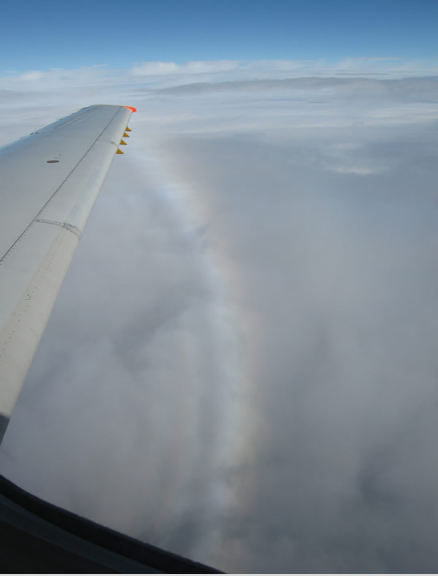Primary & seconday cloudbow and supernumeraries
Primary & Secondary Cloudbow and Supernumeraries: A Closer Look at These Atmospheric Optics Phenomena
Have you ever looked up at the sky and noticed a beautiful bow of colors forming amidst the clouds? These stunning optical displays are known as cloudbows, and they can be quite a sight to behold. In this article, we will delve into the fascinating world of primary and secondary cloudbows, as well as explore the intriguing phenomenon of supernumeraries.
Primary Cloudbow: Nature's Colorful Arch
Let's start with the primary cloudbow. Just like its more famous counterpart, the rainbow, the primary cloudbow is formed by the interaction of sunlight with water droplets in the atmosphere. When sunlight passes through these tiny droplets, it undergoes a process called refraction, causing the light to bend and separate into its constituent colors. This separation creates the beautiful arc of colors that we see in the sky.
Secondary Cloudbow: A Fainter but Equally Enchanting Delight
While the primary cloudbow steals the show with its vibrant hues, there is another bow that often accompanies it - the secondary cloudbow. This fainter bow forms at a larger angle to the sun than the primary cloudbow and is caused by a different set of water droplets. The secondary cloudbow is usually located above the primary bow and is characterized by its reversed color sequence. Instead of the usual red on the outer edge, the secondary cloudbow exhibits red on the inner edge.
Supernumeraries: Nature's Intricate Pattern
Now, let's turn our attention to the fascinating phenomenon of supernumeraries. Supernumeraries are additional bands of colors that can sometimes be seen within the primary and secondary cloudbows. These bands appear as delicate, closely spaced arcs of light, often displaying shades of pastel colors. What makes supernumeraries particularly intriguing is their reversed color sequence compared to the main bow. The innermost band of a supernumerary is typically red, followed by green, blue, and sometimes even violet.
The Science Behind Supernumeraries
Supernumeraries arise from a phenomenon known as interference. As light waves pass through the water droplets in the atmosphere, they interfere with each other, resulting in constructive and destructive interference patterns. These patterns cause the formation of the additional bands of colors within the cloudbows. The exact mechanisms behind this interference phenomenon are still a subject of ongoing research and exploration.
Observing Cloudbows and Supernumeraries
To witness the beauty of cloudbows and supernumeraries, it is essential to have the right atmospheric conditions. These optical displays are most commonly observed when there are rain showers or misty conditions in the atmosphere. The presence of small water droplets is crucial for the refraction and interference processes to occur, giving rise to the mesmerizing bows of colors.
The Rarity of Secondary Cloudbows
While primary cloudbows are relatively common and can be seen under the right conditions, secondary cloudbows are much rarer. Their faint nature makes them more challenging to spot, requiring optimal atmospheric conditions and keen observation skills. If you are fortunate enough to witness a secondary cloudbow, consider yourself lucky, as it is truly a sight to remember.
Photography and Cloudbows
Capturing the ethereal beauty of cloudbows and supernumeraries through photography can be a rewarding endeavor. By using specialized techniques and equipment, photographers can showcase these atmospheric optics phenomena in all their glory. The interplay between light, water droplets, and the surrounding sky creates an ever-changing canvas for photographers to explore.
Exploring Atmospheric Optics
The study of atmospheric optics encompasses a wide range of phenomena, from rainbows and cloudbows to halos, sundogs, and more. Each of these phenomena offers a unique window into the behavior of light in our atmosphere. By understanding the underlying science and observing these optical displays, we can gain a deeper appreciation for the wonders of our natural world.
Conclusion
Primary and secondary cloudbows, along with their accompanying supernumeraries, are awe-inspiring manifestations of the interaction between sunlight and water droplets in the atmosphere. These atmospheric optics phenomena remind us of the intricate beauty that surrounds us, even in the most ordinary of moments. So, the next time you find yourself gazing up at the sky on a misty day, take a moment to search for these captivating displays of nature's artistry.

Primary & seconday cloudbow and supernumeraries
Eva Seidenfaden (new atmospheric optics site & cloudbow images) saw this remarkable bow in September, 2006 near Manchester, England.
The unretouched image shows well the reversed colours of the two or three supernumeraries compared to those of the main bow.
To the right there is a faint and rare secondary.
Image ©Eva Seidenfaden, shown with permission.
Note: this article has been automatically converted from the old site and may not appear as intended. You can find the original article here.
Reference Atmospheric Optics
If you use any of the definitions, information, or data presented on Atmospheric Optics, please copy the link or reference below to properly credit us as the reference source. Thank you!
-
<a href="https://atoptics.co.uk/blog/primary-seconday-cloudbow-and-supernumeraries/">Primary & seconday cloudbow and supernumeraries</a>
-
"Primary & seconday cloudbow and supernumeraries". Atmospheric Optics. Accessed on April 20, 2024. https://atoptics.co.uk/blog/primary-seconday-cloudbow-and-supernumeraries/.
-
"Primary & seconday cloudbow and supernumeraries". Atmospheric Optics, https://atoptics.co.uk/blog/primary-seconday-cloudbow-and-supernumeraries/. Accessed 20 April, 2024
-
Primary & seconday cloudbow and supernumeraries. Atmospheric Optics. Retrieved from https://atoptics.co.uk/blog/primary-seconday-cloudbow-and-supernumeraries/.